change time CADILLAC DEVILLE 1998 7.G Owner's Manual
[x] Cancel search | Manufacturer: CADILLAC, Model Year: 1998, Model line: DEVILLE, Model: CADILLAC DEVILLE 1998 7.GPages: 386, PDF Size: 22.36 MB
Page 181 of 386
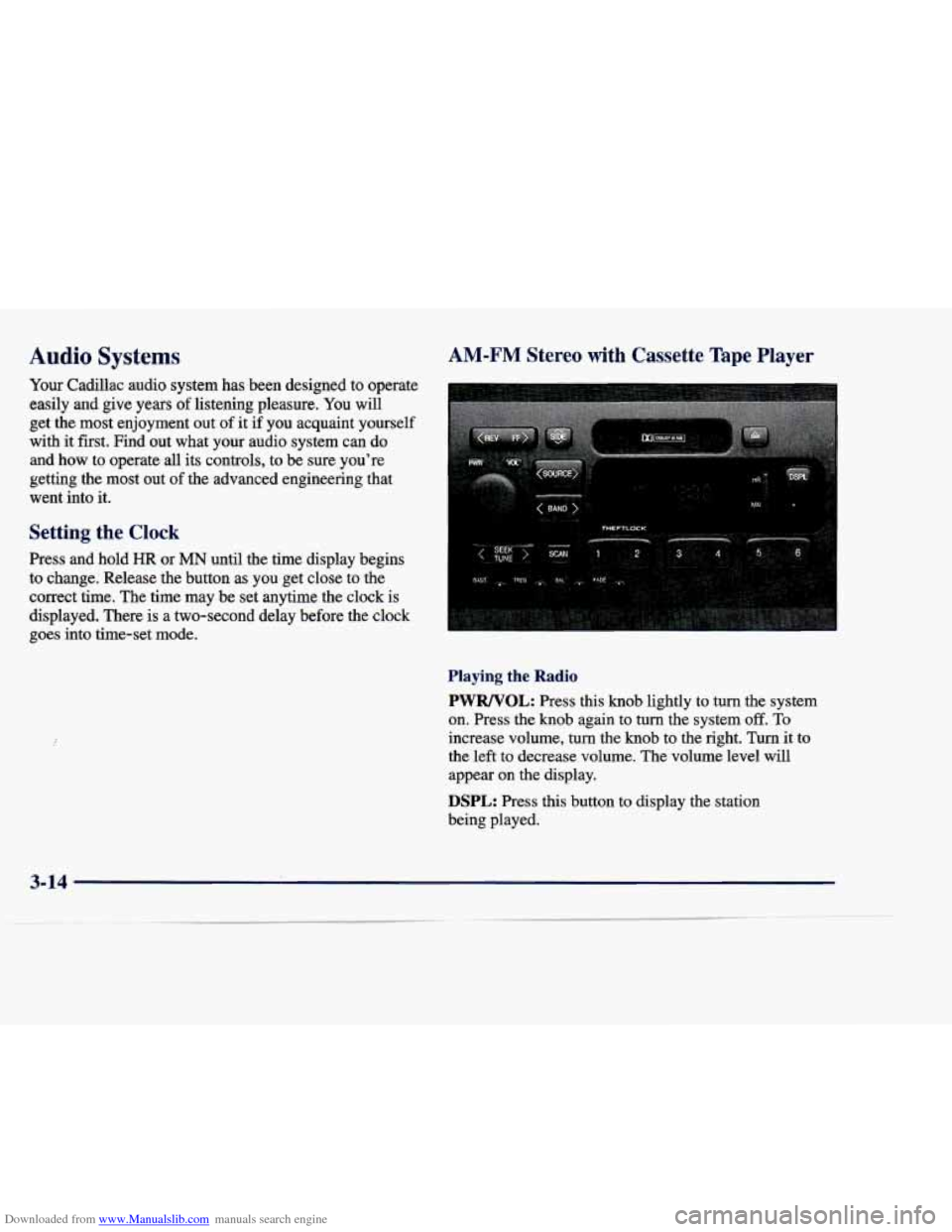
Downloaded from www.Manualslib.com manuals search engine Audio Systems AM-FM Stereo with Cassette Tape Player
Your Cadillac audio system has been designed to operate
easily and give years
of listening pleasure. You will
get the most enjoyment out of it if you acquaint yourself
with it first. Find out what your audio system can do
and how
to operate all its controls, to be sure you're
getting the most out of the advanced engineering that
went into it.
Setting the Clock
Press and hold HR or MN until the time display begins
to change. Release the button as you get close to the
correct time. The time may be set anytime the clock is
displayed. There is a two-second delay before the clock
goes into time-set mode.
Playing the Radio
PWRNOL: Press this knob lightly to turn the system
on. Press the knob again to
turn the system off. To
increase volume,
turn the knob to the right. Turn it to
the left to decrease volume. The volume level will
appear
on the display.
DSPL: Press this button to display the station
being played.
3-14
Page 184 of 386
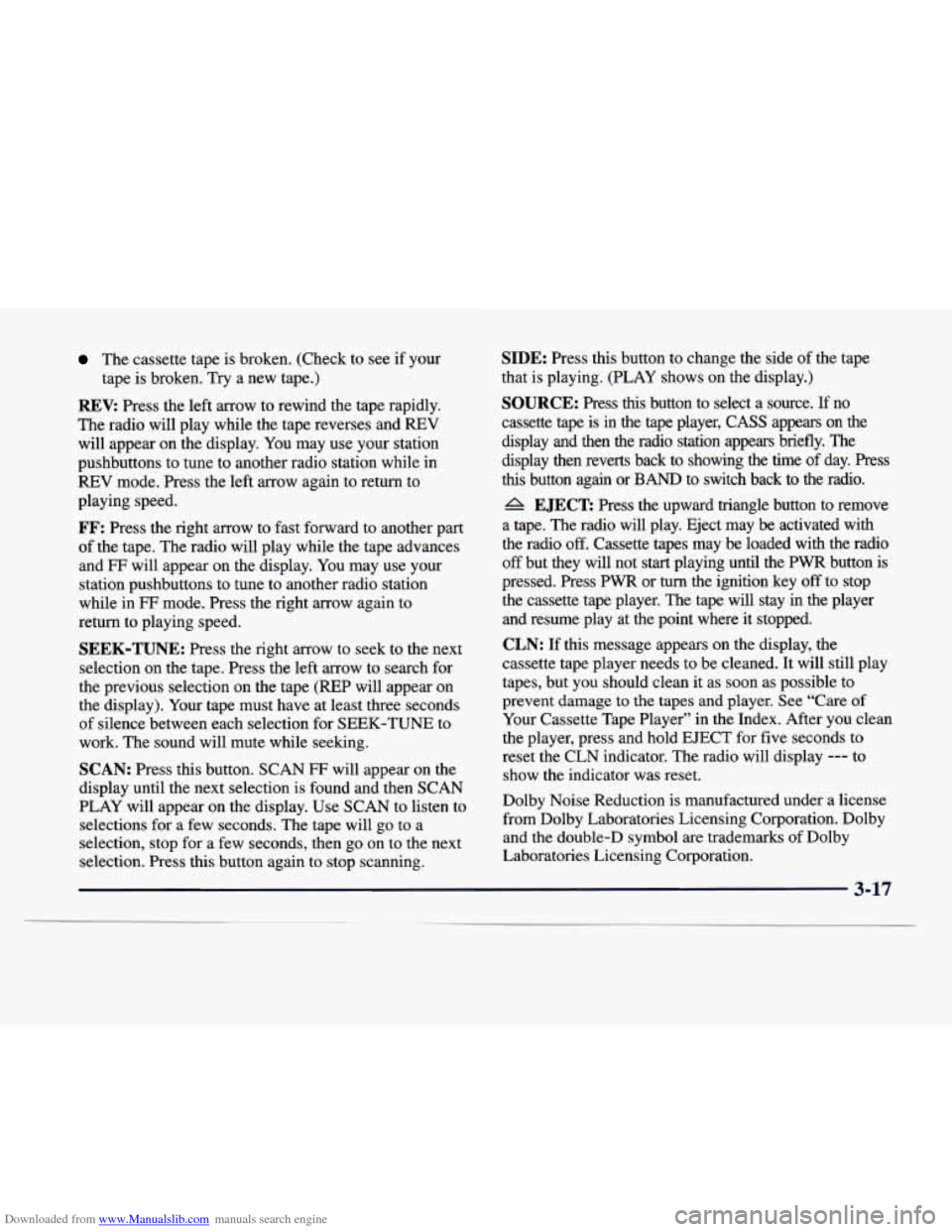
Downloaded from www.Manualslib.com manuals search engine The cassette tape is broken. (Check to see if your
REV: Press the left arrow to rewind the tape rapidly.
The radio will play while the tape reverses and
REV
will appear on the display. You may use your station
pushbuttons to tune to another radio station while
in
REV mode. Press the left arrow again to return to
playing speed.
FF: Press the right arrow to fast forward to another part
of the tape. The radio will play while the tape advances
and
FF will appear on the display. You may use your
station pushbuttons to tune to another radio station
while in
W mode. Press the right arrow again to
return to playing speed.
SEEK-TUNE: Press the right arrow to seek to the next
selection on the tape. Press the left arrow to search for
the previous selection on the tape (REP will appear on
the display). Your tape must have at least three seconds
of silence between each selection for SEEK-TUNE to
work. The sound will mute while seeking.
SCAN: Press this button. SCAN FF will appear on the
display until the next selection is found and then SCAN
PLAY will appear on the display. Use SCAN to listen
to
selections for a few seconds. The tape will go to a
selection, stop for a few seconds, then
go on to the next
selection. Press
this button again to stop scanning.
tape
is broken. Try a new tape.)
SIDE: Press this button to change the side of the tape
that is playing. (PLAY shows on the display.)
SOURCE: Press this button to select a source. If no
cassette tape is
in the tape player, CASS appears on the
display and then the radio station appears briefly. The
display then reverts back to showing the time of day. Press
this button again or BAND to switch back to the radio.
A EJECT Press the upward triangle button to remove
a tape. The radio will play. Eject may be activated with
the radio
off. Cassette tapes may be loaded with the radio
off but they will not start playing until the PWR button is
pressed. Press PWR or
turn the ignition key off to stop
the cassette tape player. The tape will stay in the player
and resume play at the point where it stopped.
CLN: If this message appears on the display, the
cassette tape player needs to be cleaned.
It will still play
tapes, but you should clean it as soon as possible to
prevent damage to the tapes and player. See “Care
of
Your Cassette Tape Player” in the Index. After you clean
the player, press and hold EJECT for five seconds to
reset the CLN indicator. The radio will display
--- to
show the indicator was reset.
Dolby Noise Reduction is manufactured under a license
from Dolby Laboratories Licensing Corporation. Dolby and the double-D symbol are trademarks
of Dolby
Laboratories Licensing Corporation.
3-17
Page 201 of 386
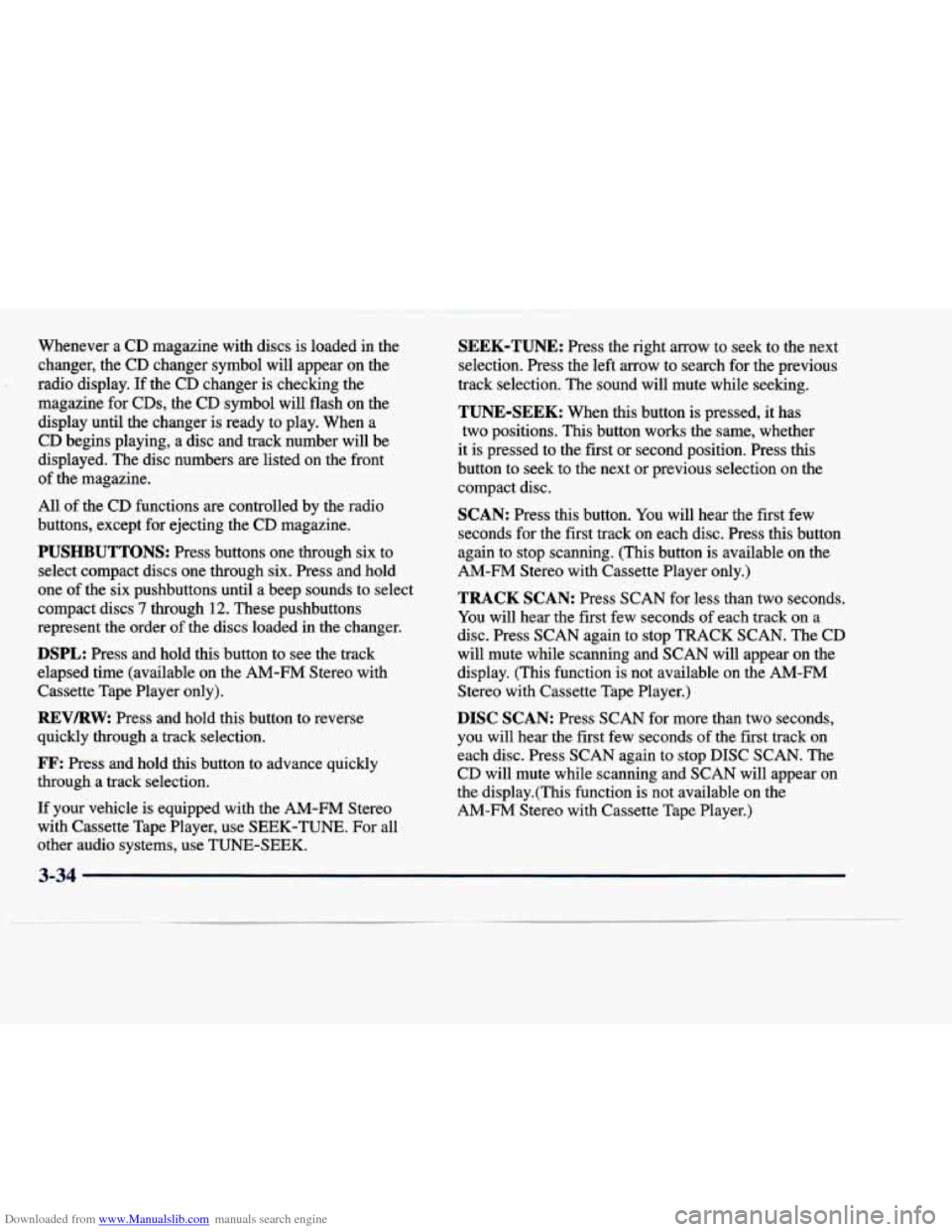
Downloaded from www.Manualslib.com manuals search engine Whenever a CD magazine with discs is loaded in the
changer, the CD changer symbol will appear on the
magazine for CDs, the CD symbol will flash on the
display until the changer is ready to play. When a
CD begins playing, a disc and track number will be
displayed. The disc numbers are listed on the front of the magazine.
All
of the CD functions are controlled by the radio
buttons, except for ejecting the CD magazine.
PUSHBUTTONS: Press buttons one through six to
select compact discs one through six. Press and hold
one of the six pushbuttons until a beep sounds to select
compact discs
7 through 12. These pushbuttons
represent the order
of: the discs loaded in the changer.
DSPL: Press and hold this button to see the track
elapsed time (available on the
AM-FM Stereo with
Cassette Tape Player only).
REV/RW Press and hold this button to reverse
quickly through a track selection.
FF: Press and hold this button to advance quickly
through a track selection.
If your vehicle is equipped with the
AM-FM Stereo
with Cassette Tape Player, use SEEK-TUNE. For all
other audio systems, use TUNE-SEEK.
I radio display. If the CD changer is checking the
SEEK-TUNE: Press the right arrow to seek to the next
selection. Press the left arrow to search for the previous
track selection. The sound
will mute while seeking.
TUNE-SEEK: When this button is pressed, it has
two positions. This button works the same, whether
it is pressed to the first or second position. Press this
button to seek to the' next or previous selection on the
compact disc.
SCAN: Press this button. You will hear the first few
seconds for the first track
on each disc. Press this button
again to stop scanning. (This button
is available on the
AM-FM Stereo with Cassette Player only.)
TRACK SCAN: Press SCAN for less than two seconds.
You will hear the first few seconds of each track on a
disc. Press SCAN again to stop TRACK SCAN. The CD
will mute while scanning and SCAN will appear on the
display. (This function is not available on the AM-FM
Stereo with Cassette Tape Player.)
DISC SCAN: Press SCAN for more than two seconds,
you will hear the first few seconds of the first track
on
each disc. Press SCAN again to stop DISC SCAN. The
CD will mute while scanning and SCAN will appear on
the display.(This function is not available on the
AM-FM Stereo with Cassette Tape Player.)
3-34
Page 202 of 386
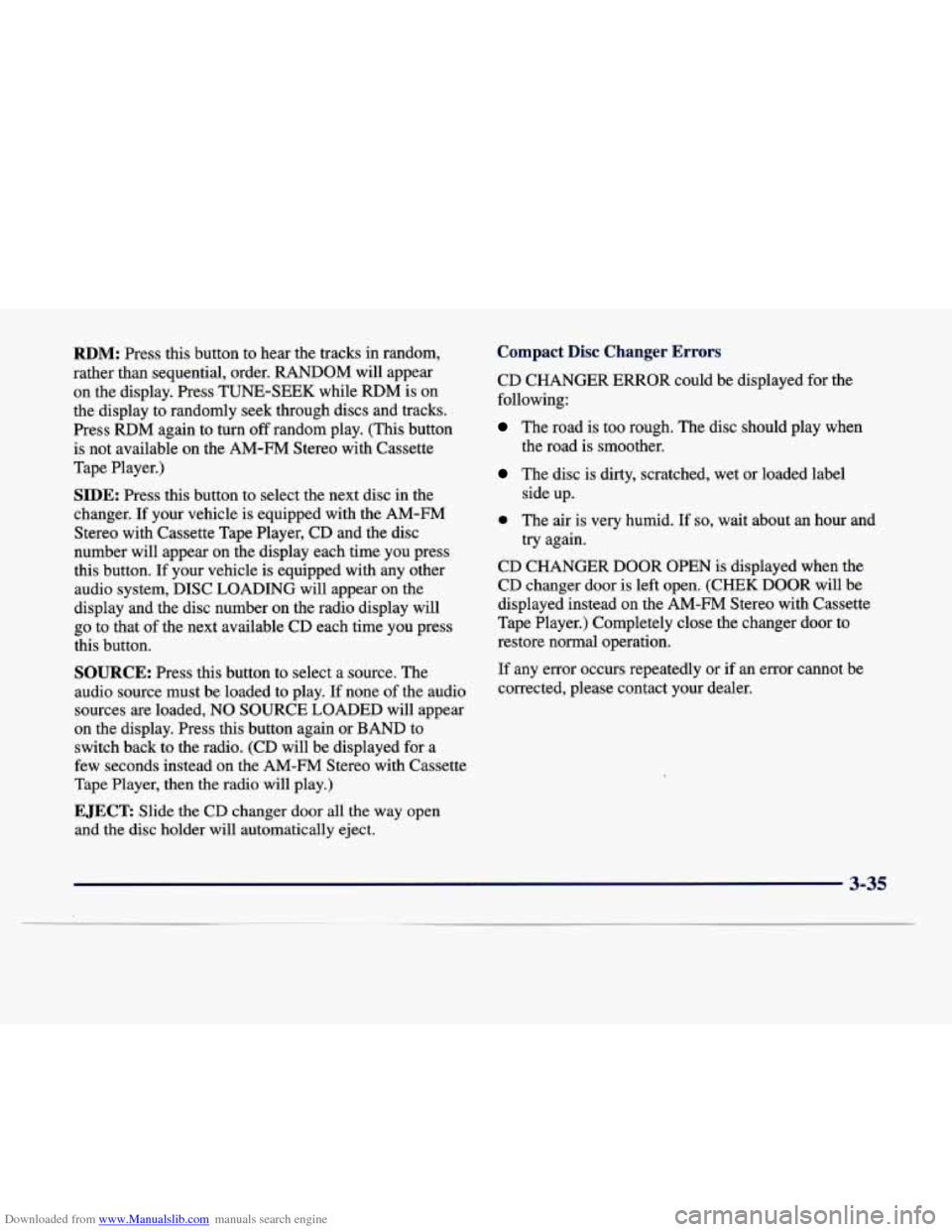
Downloaded from www.Manualslib.com manuals search engine RDM: Press this button to hear the tracks in random,
rather than sequential, order. RANDOM will appear on the display. Press TUNE-SEEK while RDM is on
the display to randomly seek through discs and tracks.
Press RDM again to turn
off random play. (This button
is not available on the
AM-FM Stereo with Cassette
Tape Player.)
SIDE: Press this button to select the next disc in the
changer. If your vehicle
is equipped with the AM-FM
Stereo with Cassette Tape Player, CD and the disc
number will appear on the display each time you press
this button.
If your vehicle is equipped with any other
audio system, DISC LOADING will appear on the
display and the disc number on the radio display will
go to that of the next available CD each time you press
this button.
SOURCE: Press this button to select a source. The
audio source must be loaded to play.
If none of the audio
sources
are loaded, NO SOURCE LOADED will appear
on the display. Press this button again or BAND to
switch back to the radio. (CD will be displayed
for a
few seconds instead on the AM-FM Stereo with Cassette
Tape Player, then the radio will play.)
EJECT Slide the CD changer door all the way open
and the disc holder will automatically eject.
Compact Disc Changer Errors
CD CHANGER ERROR could be displayed for the
following:
The road is too rough. The disc should play when
the road is smoother.
The disc is dirty, scratched, wet or loaded label
0 The air is very humid. If so, wait about an hour and
CD CHANGER DOOR OPEN is displayed when the
CD changer door
is left open. (CHEK DOOR will be
displayed instead on the AM-FM Stereo with Cassette
Tape Player.) Completely close the changer door to
restore normal operation.
If any error occurs repeatedly or if an error cannot be
corrected, please contact your dealer. side
up.
try again.
3-35
Page 220 of 386
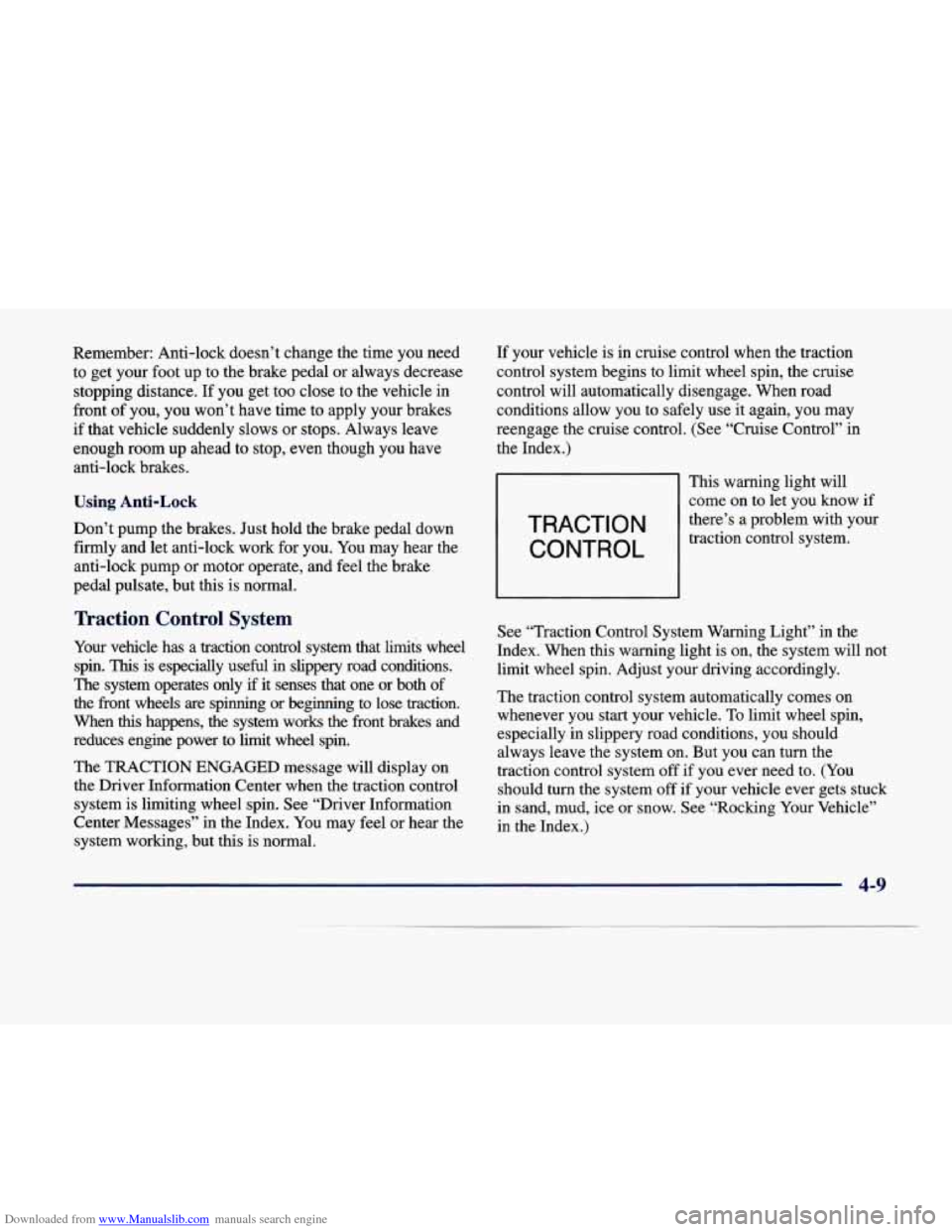
Downloaded from www.Manualslib.com manuals search engine Remember: Anti-lock doesn’t change the time you need to get your foot up to the brake pedal or always decrease
stopping distance.
If you get too close to the vehicle in
front of you, you won’t have time to apply your brakes
if that vehicle suddenly slows or stops. Always leave
enough room up ahead to stop, even though you have anti-lock brakes.
Using Anti-Lock
Don’t pump the brakes. Just hold the brake pedal down
firmly and let anti-lock work for you. You may hear the
anti-lock pump or motor operate, and
1 1 the brake
pedal pulsate, but this is normal.
Traction Control System
Your vehicle has a traction control system that limits wheel
spin.
This is especially useful in slippery road conditions.
The system operates only
if it senses that one or both of
the front wheels are spinning or beginning to lose traction.
When
this happens, the system works the front brakes and
reduces engine power to limit wheel spin.
The TRACTION
ENGAGED message will display on
the Driver Information Center when the traction control
system is limiting wheel spin. See “Driver Information
Center Messages” in the Index. You may feel or hear the
system working, but this is normal. If
your vehicle is in cruise control when the traction
control system begins to limit wheel spin, the cruise
control will automatically disengage. When road
conditions allow
you to safely use it again, you may
reengage the cruise control. (See “Cruise Control” in
the Index.)
TRACTION
CONTROL
This warning light will come on to let you know if
there’s a problem with your
traction control system.
See “Traction Control System Warning Light” in the
Index. When this warning light is on, the system will not
limit wheel spin. Adjust your driving accordingly.
The traction control system automatically comes on whenever you start your vehicle. To limit wheel spin,
especially in slippery road conditions, you should always leave the system
on. But you can turn the
traction control system
off if you ever need to. (You
should turn the system
off if your vehicle ever gets stuck
in sand, mud, ice or snow. See ‘.‘Rocking Your Vehicle”
in the Index.)
4-9
Page 221 of 386
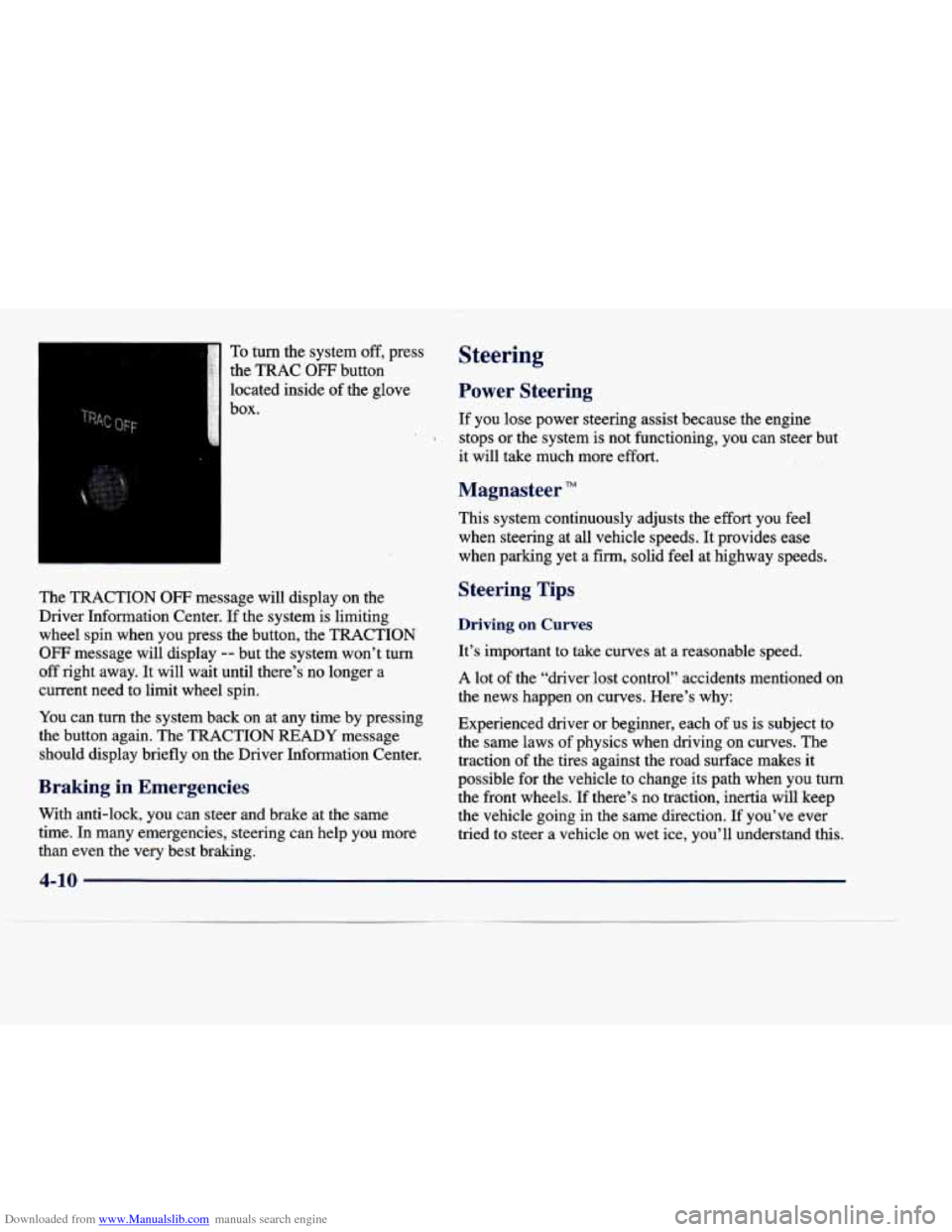
Downloaded from www.Manualslib.com manuals search engine To turn the system off, press
RAC
OFF button
.; . located inside of the glove
:. : :
The TRACTION OFF message will display on the
Driver Information Center. If the system is limiting
wheel spin when you press the button, the TRACTION
OFF message will display -- but the system won’t turn
off right away.
It will wait until there’s no longer a
current need to limit wheel spin.
You can turn the system back on at any time by pressing
the button again. The TRACTION READY message should display briefly on the Driver Information Center.
Braking in Emergencies
With anti-lock, you can steer and brake at the same
time. In many emergencies, steering can help you more
than even the very best braking.
Steering
Power Steering
If you lose power steering assist because the engine
stops or the system is not functioning, you can steer but
it will take much more effort.
Magnas tec ~-
This system conrmuously adjusts the effort you feel
when steering at all vehicle speeds. It provides ease
when parking yet a
firm, solid feel at highway speeds.
Steering Tips
Driving on Curves
It’s important to take curves at a reasonable speed.
A lot of the “driver lost control” accidents mentioned on
the news happen on curves. Here’s why:
Experienced driver
or beginner, each of us is subject to
the same laws of physics when driving on curves. The
traction of the tires against the road surface makes it
possible for the vehicle to change its path when you turn
the front wheels. If there’s no traction, inertia will keep \
the vehicle going in the same direction.
If you’ve ever
tried to steer a vehicle on wet ice, you’ll understand
this.
4-10
Page 225 of 386
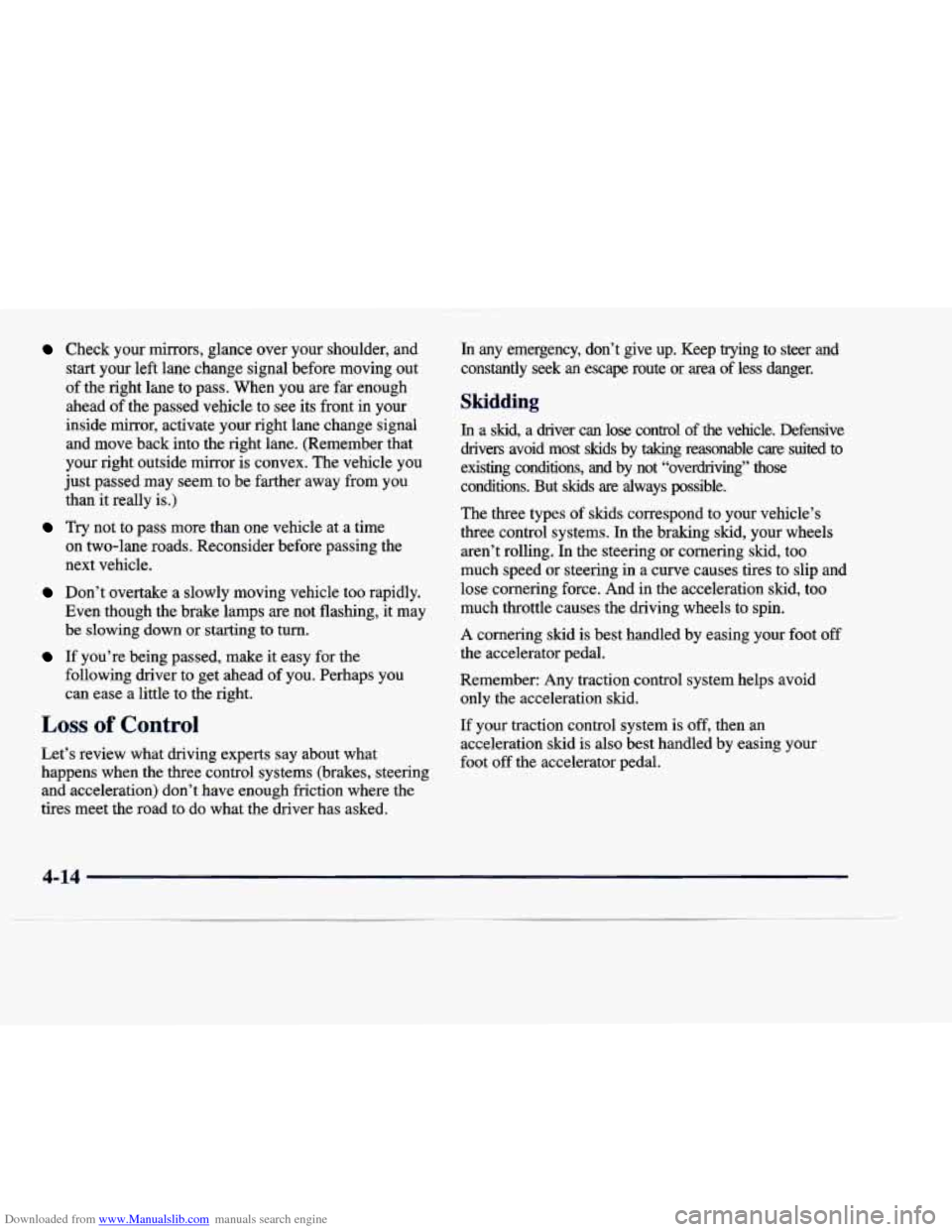
Downloaded from www.Manualslib.com manuals search engine Check your mirrors, glance over your shoulder, and start your left lane change signal before moving out
of the right
lane to pass. When you are far enough
ahead of the passed vehicle to see its front in your
inside mirror, activate your right lane change signal and move back into the right lane. (Remember that
your right outside mirror is convex. The vehicle you
just passed may seem to be farther away from you
than it really is.)
Try not to pass more than one vehicle at a time
on two-lane roads. Reconsider before passing the
next vehicle.
Don’t overtake a slowly moving vehicle too rapidly.
Even though the brake lamps are not flashing, it may
be slowing down or starting to turn.
following driver to get ahead of you. Perhaps you
can ease a little to the right.
If you’re being passed, make it easy for the
Loss of Control
Let’s review what driving experts say about what
happens when the three control systems (brakes, steering
and acceleration) don’t have enough friction where
the
tires meet the road to do what the driver has asked.
In any emergency, don’t give up. Keep trying to steer and
constantly seek an escape route or area of less danger.
Skidding
In a skid, a driver can lose control of the vehicle. Defensive
drivers avoid most
skids by taking reasonable care suited to
existing conditions, and by not “overdriving” those
conditions. But
skids are always possible.
The three types of skids correspond to your vehicle’s
three control systems. In the braking skid, your wheels aren’t rolling. In the steering or cornering skid, too
much speed or steering in a curve causes tires to slip and
lose cornering force. And in the acceleration skid, too
much throttle causes the driving wheels to spin.
A cornering skid is best handled by easing your foot off
the accelerator pedal.
Remember: Any traction control system helps avoid
only the acceleration skid.
If your traction control system is
off, then an
acceleration skid is
also best handled by easing your
foot
off the accelerator pedal.
4-14
Page 243 of 386
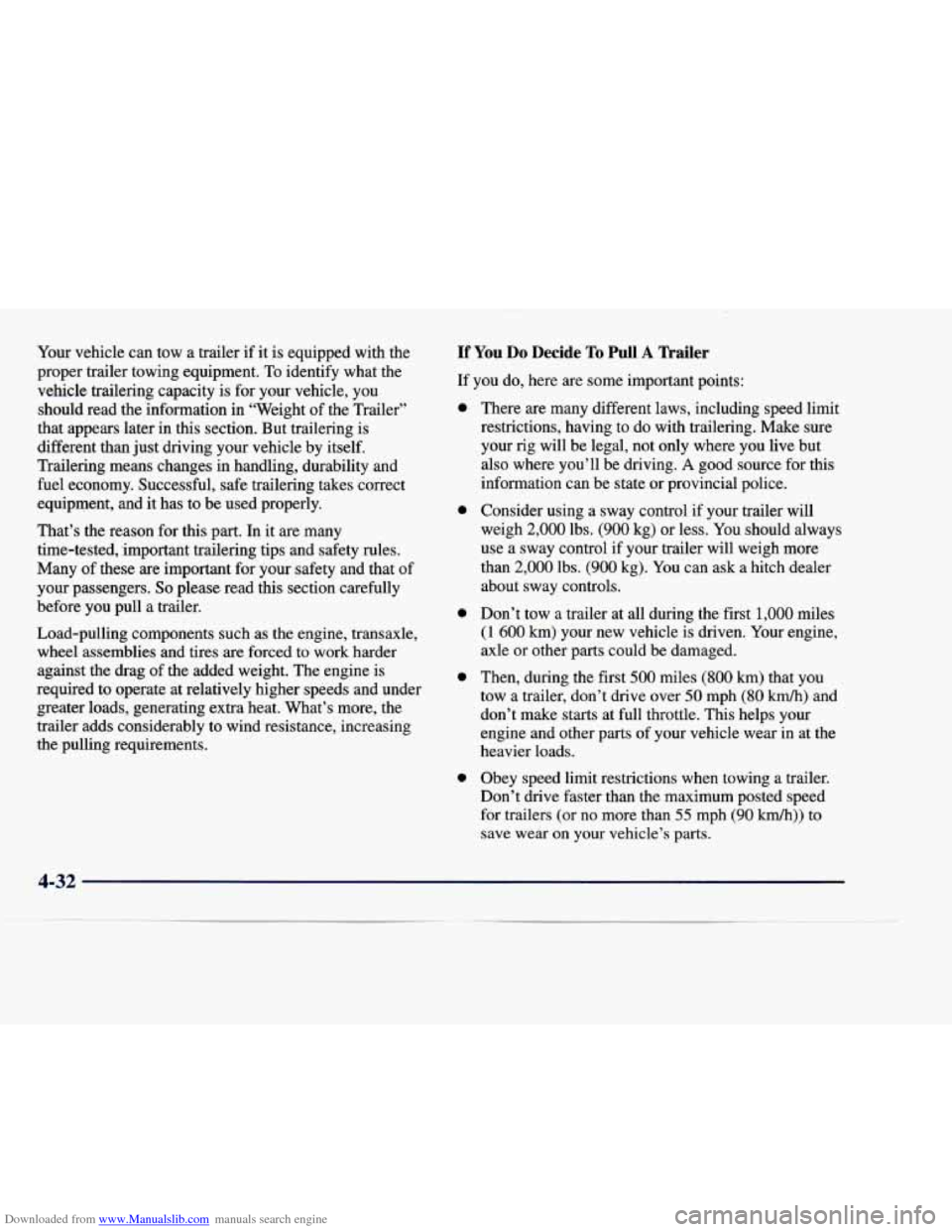
Downloaded from www.Manualslib.com manuals search engine Your vehicle can tow a trailer if it is equipped with the
proper trailer towing equipment. To identify what the
vehicle trailering capacity is for your vehicle, you
should read the information in “Weight of the Trailer”
that appears later in this section. But trailering is
different than just driving your vehicle by itself.
Trailering means changes in handling, durability and
fuel economy. Successful, safe trailering takes correct
equipment, and it has to be used properly.
That’s the reason for this part. In it are many
time-tested, ,important trailering tips and safety rules.
Many
of these are important for your safety and that of
your passengers.
So please read this section carefully
before you pull a trailer.
Load-pulling components such as the engine, transaxle,
wheel assemblies and tires
are forced to work harder
against the drag
of the added weight. The engine is
required to operate at relatively higher speeds and under
greater loads, generating extra heat. What’s more, the
trailer adds considerably to wind resistance, increasing
the pulling requirements.
If You Do Decide To Pull A Trailer
If you do, here are some important points:
0
0
0
0
0
There are many different laws, including speed limit
restrictions, having
to do with trailering. Make sure
your rig
will be legal, not only where you live but
also where you’ll be driving.
A good source for this
information can be state or provincial police.
Consider using a sway control if your trailer will
weigh
2,000 lbs. (900 kg) or less. You should always
use a sway control if your trailer will weigh more
than
2,000 lbs. (900 kg). You can ask a hitch dealer
about sway controls.
Don’t tow
a trailer at all during the first 1,000 miles
(1 600 km) your new vehicle is driven. Your engine,
axle or other parts could be damaged.
Then, during the first
500 miles (800 km) that you
tow a trailer, don’t drive over
50 mph (80 km/h) and
don’t make starts at full throttle. This helps your
engine and other parts of your vehicle wear in at the
heavier
loads.
Obey speed limit restrictions when towing a trailer.
Don’t drive faster than the maximum posted speed
for trailers (or no more than
55 mph (90 km/h)) to
save wear on your vehicle’s parts.
4-32
Page 279 of 386

Downloaded from www.Manualslib.com manuals search engine 6. Remove any rust or dirt
from the wheel bolts,
mounting
surfaces and
spare wheel.
-
Rust or dirt on the wheel, or on the parts to
which
it is fastened, can make the wheel nuts
become loose after
a time. The wheel could come
off and cause an accident. When you change
a
wheel, remove any rust or dirt from the places
where the wheel attaches to the vehicle. In an
emergency, you can use
a cloth or a paper towel
to do this;
but be sure to use a scraper or wire
brush later,
if you need to, to get all the rust or
dirt off.
A CAJTION:
Never use oil or grease on studs or nuts. If you
do, the nuts might come loose. Your wheel could
fall
off, causing a serious accident.
7. Replace the wheel nuts
with the rounded end
of
the nuts toward the
wheel. Tighten each nut
5-30
Page 302 of 386
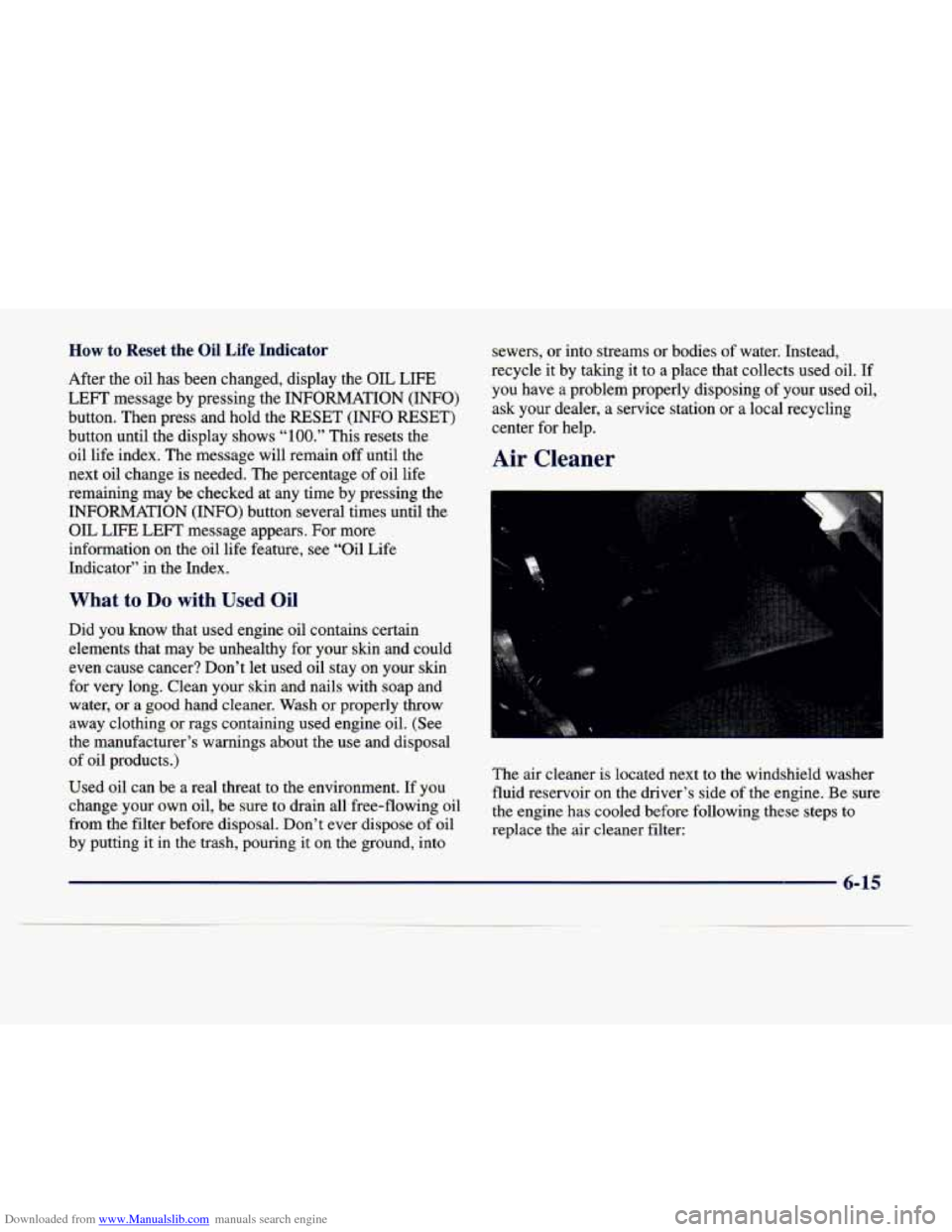
Downloaded from www.Manualslib.com manuals search engine How to Reset the Oil Life Indicator
After the oil has been changed, display the OIL LIFE
LEFT message by pressing the INFORMATION (INFO)
button. Then press and hold the RESET (INFO RESET)
button until the display shows
“100.” This resets the
oil life index. The message will remain off until the
next oil change is needed. The percentage of oil life
remaining may be checked at any time by pressing the
INFORMATION (INFO) button several times until the
OIL LIFE LEFT message appears. For more
information on the oil life feature, see “Oil Life
Indicator”
in the Index.
What to Do with Used Oil
Did you know that used engine oil contains certain
elements that may be unhealthy for your
skin and could
even cause cancer? Don’t let used oil stay
on your skin
for
very long. Clean your skin and nails with soap and
water, or a good hand cleaner. Wash or properly throw
away clothing or rags containing used engine oil. (See
the manufacturer’s warnings about the use and disposal
of oil products.)
Used oil can be a real threat to the environment. If you
change your own oil, be sure to drain all free-flowing oil
from the filter before disposal. Don’t ever dispose of oil
by putting it in the trash, pouring
it on the ground, into sewers,
or into streams or bodies of water. Instead,
recycle it by taking it to a place that collects used oil.
If
you have a problem properly disposing of your used oil,
ask your dealer, a service station or a local recycling
center for help.
Air Cleaner
The air cleaner is located next to the windshield washer
fluid reservoir on the driver’s side
of the engine. Be sure
the engine has cooled before following these steps to
replace the air cleaner filter:
6-15